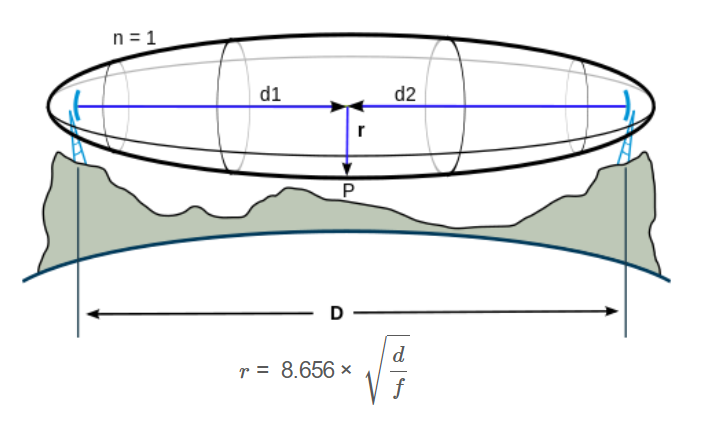1. What is a Fresnel Zone?
Definition: The Fresnel Zone is an elliptical region around the direct line-of-sight path between a transmitter and receiver where the RF signal propagates. The first Fresnel zone is the most critical for signal integrity.
Purpose: Calculating the Fresnel Zone helps ensure that the signal path is sufficiently clear of obstacles, which is essential for reliable wireless communication in systems like microwave links, Wi-Fi, and cellular networks.
2. How Does the Calculator Work?
The calculator uses the formula for the radius of the first Fresnel zone:
\[
r = 8.656 \times \sqrt{\frac{d}{f}}
\]
Where:
- \( r \): Radius of the first Fresnel zone (initially in meters, then converted to the selected unit)
- \( d \): Distance in km (converted from meters, feet, or miles if necessary)
- \( f \): Frequency in GHz (converted from Hz, kHz, or MHz if necessary)
It also computes the 60% clearance radius (\( 0.6 \times r \)), which is the recommended clear area to minimize signal interference.
Steps:
- Enter the distance \( d \) and select its unit (meters, km, feet, or miles).
- Enter the frequency \( f \) and select its unit (Hz, kHz, MHz, GHz).
- Click "Calculate" to compute the first Fresnel zone radius and the 60% clearance radius.
- Select the output unit for each radius (cm, m, in, ft, km, miles) in the result section.
- Results are displayed in the selected units, along with the fixed 60% clearance percentage.
3. Importance of Fresnel Zone Calculations
Fresnel Zone calculations are crucial for:
- Link Reliability: Ensures minimal signal loss by keeping the first Fresnel zone clear of obstructions.
- System Design: Helps in planning antenna heights and positioning for point-to-point wireless links.
- Interference Mitigation: Reduces the impact of reflections and diffractions that can degrade signal quality.
4. Using the Calculator
Examples:
- Example 1: Wi-Fi Frequency (Radius in Meters, Clearance in Meters)
- \( d = 1 \, \text{km}, f = 2.4 \, \text{GHz} \)
- \( r = 8.656 \times \sqrt{\frac{1}{2.4}} \approx 5.59 \, \text{m} \)
- 60% Clearance Radius: \( 0.6 \times 5.59 = 3.35 \, \text{m} \)
- Example 2: Distance in Feet (Radius in Feet, Clearance in Inches)
- \( d = 1640.42 \, \text{feet}, f = 900 \, \text{MHz} \)
- Convert: \( d = 1640.42 \times 0.0003048 = 0.5 \, \text{km}, f = 0.9 \, \text{GHz} \)
- \( r = 8.656 \times \sqrt{\frac{0.5}{0.9}} \approx 6.45 \, \text{m} \)
- Radius in feet: \( 6.45 \times 3.28084 \approx 21.16 \, \text{ft} \)
- Clearance in inches: \( (0.6 \times 6.45) \times 39.3701 \approx 152.28 \, \text{in} \)
- Example 3: Distance in Miles (Radius in Inches, Clearance in Feet)
- \( d = 6.2137 \, \text{miles}, f = 100 \, \text{MHz} \)
- Convert: \( d = 6.2137 \times 1.60934 = 10 \, \text{km}, f = 0.1 \, \text{GHz} \)
- \( r = 8.656 \times \sqrt{\frac{10}{0.1}} \approx 86.56 \, \text{m} \)
- Radius in inches: \( 86.56 \times 39.3701 \approx 3407.88 \, \text{in} \)
- Clearance in feet: \( (0.6 \times 86.56) \times 3.28084 \approx 170.50 \, \text{ft} \)
5. Frequently Asked Questions (FAQ)
Q: What is the first Fresnel zone?
A: The first Fresnel zone is the innermost elliptical region around the line-of-sight path where the RF signal travels. It has the most significant impact on signal strength.
Q: Why is 60% clearance recommended?
A: Keeping 60% of the first Fresnel zone clear minimizes signal interference from reflections and diffractions, ensuring a reliable link while allowing for practical deployment constraints.
Q: How does unit conversion work in the calculator?
A: The calculator converts input distance to km (e.g., 1000 m = 1 km, 3280.84 ft = 1 km, 0.621371 miles = 1 km) and frequency to GHz (e.g., 1000 MHz = 1 GHz). The radius is calculated in meters and then converted to the selected output unit (e.g., 1 m = 100 cm, 1 m = 3.28084 ft).
Fresnel Zone Calculator© - All Rights Reserved 2025
 Home
Home
 Back
Back
